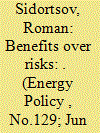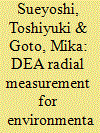| Srl | Item |
| 1 |
ID:
166561


|
|
|
|
|
| Summary/Abstract |
Projected benefits serve as the driving force behind hydrocarbon development. Such benefits are analysed in conjunction with the risks posed by proposed oil and gas activities, leading to an ostensibly rational decision on whether to proceed with the development. This article explores the ways and extent to which government policies aimed at supporting the oil and gas sector affect the outcomes of decision-making processes regarding new hydrocarbon projects. The article is premised upon a case study of the Russian Arctic and Subarctic. The study utilizes transcripts of key presidential meetings and speeches, as well as applicable programmatic policy statements, laws, and administrative regulations. The data is subjected to the complimentary and corroborative discourse and legal analyses. The article concludes that the dominance of benefits over risks in the policy discourse is particularly impactful in the decision-making process regarding new oil and gas development in Russia.
|
|
|
|
|
|
|
|
|
|
|
|
|
|
|
|
| 2 |
ID:
111348


|
|
|
|
|
| Publication |
2012.
|
| Summary/Abstract |
Energy policy depends on a proper use of methodology in guiding a large energy issue such as the global warming and climate change. DEA is one of such methodologies that are often used for preparing environmental policy, which is closely linked to various energy issues. Unfortunately, the use of DEA applied to environmental policy is insufficient, often misguiding policy makers and other individuals who are involved in energy issues. This study provides three guidelines for a use of DEA in preparing environmental assessment. First, it is important to prepare both primal and dual formulations to confirm whether information regarding all production factors (i.e., inputs, desirable and undesirable outputs) is fully utilized in DEA assessment. Second, DEA has model variations in radial and non-radial measurements. It is necessary for us to examine environmental issues by different models in order to avoid a methodological bias existing in those empirical studies. Finally, DEA environmental assessment needs to incorporate the concept of natural and managerial disposability. The natural disposability indicates that a firm negatively adapts a regulation change on undesirable outputs. In contrast, the managerial disposability indicates that a firm positively adapts the regulation change because the firm considers the regulation change as a new business opportunity.
|
|
|
|
|
|
|
|
|
|
|
|
|
|
|
|
| 3 |
ID:
047028


|
|
|
|
|
| Publication |
London, Lewis Publishers, 2001.
|
| Description |
456p.Hbk
|
| Standard Number |
1566705592
|
|
|
|
|
|
|
|
|
|
|
|
Copies: C:1/I:0,R:0,Q:0
Circulation
| Accession# | Call# | Current Location | Status | Policy | Location |
| 044480 | 658.408/ECC 044480 | Main | On Shelf | General | |
|
|
|
|